Deposition, Characterization, and Modeling of Scandium-Doped Aluminum Nitride Thin Film for Piezoelectric Devices
Abstract
:1. Introduction
2. Experimental
2.1. Deposition of ScAlN Thin Film
2.2. Characterization of ScAlN Thin Film
2.3. Crystal Structure Modeling of ScAlN Thin Film
3. Results and Discussion
3.1. Microstructural and Crystal Structure Properties
3.2. Crystal Orientation and Piezoelectric Properties
3.3. High-Pressure Properties
4. Conclusions
Author Contributions
Funding
Institutional Review Board Statement
Informed Consent Statement
Data Availability Statement
Acknowledgments
Conflicts of Interest
References
- Mariotti, G.; Vannozzi, L. Fabrication, characterization, and properties of poly (ethylene-co-vinyl acetate) composite thin films doped with piezoelectric nanofillers. Nanomaterials 2019, 9, 1182. [Google Scholar] [CrossRef] [Green Version]
- Jin, C.; Hao, N.; Xu, Z.; Trase, I.; Nie, Y.; Dong, L.; Closson, A.; Chen, Z.; Zhang, J.X.J. Flexible piezoelectric nanogenerators using metal-doped ZnO-PVDF films. Sens. Actuators A 2020, 305, 111912. [Google Scholar] [CrossRef] [PubMed]
- Talbi, A.; Sarry, F.; Brizoual, L.L.; Elmazria, O.; Alnot, P. Sezawa mode SAW pressure sensors based on ZnO/Si structure. IEEE Trans. Ultrason. Ferroelect. Freq. Control 2004, 51, 1421–1426. [Google Scholar] [CrossRef]
- Dubois, M.-A.; Muralt, P. Properties of aluminum nitride thin films for piezoelectric transducers and microwave filter applications. Appl. Phys. Lett. 1999, 74, 3032–3034. [Google Scholar] [CrossRef]
- Tadigadapa, S.; Mateti, K. Piezoelectric MEMS sensors: State-of-the-art and perspectives. Meas. Sci. Technol. 2009, 20, 092001. [Google Scholar] [CrossRef]
- Akiyama, M.; Kamohara, T.; Kano, K.; Teshigahara, A.; Takeuchi, Y.; Kawahara, N. Enhancement of piezoelectric response in scandium aluminum nitride alloy thin films prepared by dual reactive cosputtering. Adv. Mater. 2009, 21, 593–596. [Google Scholar] [CrossRef] [PubMed]
- Wingqvist, G.; Tasnadi, F.; Zukauskaite, A.; Birch, J.; Arwin, H.; Hultman, L. Increased electromechanical coupling in w−ScxAl1−xN. Appl. Phys. Lett. 2010, 97, 112902. [Google Scholar] [CrossRef]
- Piazza, G.; Felmetsger, V.; Muralt, P.; Olsson, R.H.; Ruby, R. Piezoelectric aluminum nitride thin films for microelectromechanical systems. MRS Bull. 2012, 37, 1051–1061. [Google Scholar] [CrossRef] [Green Version]
- Yantchev, V.; Katardjiev, I. Thin film Lamb wave resonators in frequency control and sensing applications: A review. J. Micromech. Microeng. 2013, 23, 043001. [Google Scholar] [CrossRef]
- Takeuchi, N. First-principles calculations of the ground-state properties and stability of ScN. Phys. Rev. B 2002, 65, 045204. [Google Scholar] [CrossRef]
- Zoroddu, A.; Bernardini, F.; Ruggerone, P.; Fiorentini, V. First-principles prediction of structure, energetics, formation enthalpy, elastic constants, polarization, and piezoelectric constants of AlN, GaN, and InN: Comparison of local and gradient-corrected density-functional theory. Phys. Rev. B 2001, 64, 045208. [Google Scholar] [CrossRef] [Green Version]
- Mancera, L.; Rodríguez, J.A.; Takeuchi, N. Theoretical study of the stability of wurtzite, zinc-blende, NaCl and CsCl phases in group IIIB and IIIA nitrides. Phys. Status Solidi. B 2004, 241, 2424. [Google Scholar] [CrossRef]
- Farrer, N.; Bellaiche, L. Properties of Hexagonal ScN versus Wurtzite GaN and InN. Phys. Rev. B 2002, 66, 201203. [Google Scholar] [CrossRef]
- Ranjan, V.; Bin-Omran, S.; Sichuga, D.; Nichols, R.S.; Bellaiche, L.; Alsaad, A. Properties of GaN/ScN and InN/ScN superlattices from first principles. Phys. Rev. B 2005, 72, 085315. [Google Scholar] [CrossRef]
- Alsaad, A.; Ahmad, A. Piezoelectricity of ordered (ScxGa1−xN) alloys from first principles. Eur. Phys. J. 2006, 54, 151–156. [Google Scholar] [CrossRef]
- Wang, Q.; Lu, Y.; Mishin, S.; Oshmyansky, Y.; Horsley, D.A. Design, fabrication, and characterization of scandium aluminum nitride-based piezoelectric micromachined ultrasonic transducers. J. Microelectromech. Syst. 2017, 26, 1132. [Google Scholar] [CrossRef]
- Moreira, M.; Bjurström, J.; Katardjev, I.; Yantchev, V. Aluminum scandium nitride thin-film bulk acoustic resonators for wide band applications. Vacuum 2011, 86, 23–26. [Google Scholar] [CrossRef]
- Hashimoto, K.; Sato, S.; Teshigahara, A.; Nakamura, T.; Kano, K. High-performance surface acoustic wave resonators in the 1 to 3 GHz range using a ScAlN/6H-SiC structure. IEEE Trans. Ultrason. Ferroelect. Freq. Control 2013, 60, 637–642. [Google Scholar] [CrossRef]
- Hardy, M.T.; Downey, B.P.; Nepal, N.; Storm, D.F.; Katzer, D.S.; Meyer, D.J. Epitaxial ScAlN grown by molecular beam epitaxy on GaN and SiC substrates. Appl. Phys. Lett. 2017, 110, 162104. [Google Scholar] [CrossRef]
- Sumisaka, M.; Yamazaki, K.; Fujii, S.; Tang, G.; Han, T.; Suzuki, Y.; Otomo, S.; Omori, T.; Hashimoto, K. Sputter deposition of ScAlN using large size alloy target with high Sc content and reduction of Sc content in deposited films. Jpn. J. Appl. Phys. 2015, 54, 07HD06. [Google Scholar] [CrossRef]
- Li, X.-H.; Wang, S.; Xie, H.; Wei, Y.O.; Kao, T.-T.; Satter, M.M.; Shen, S.-C.; Douglas Yoder, P.; Detchprohm, T.; Dupuis, R.D.; et al. Growth of high-quality AlN layers on sapphire substrates at relatively low temperatures by metalorganic chemical vapor deposition. Phys. Status Solidi B 2015, 252, 1089–1095. [Google Scholar] [CrossRef]
- Arakawa, K.; Yanagitani, T.; Kano, K.; Teshigahara, A.; Akiyama, M. Deposition techniques of c-axis-tilted ScAlN films by conventional RF magnetron sputtering. In Proceedings of the 2010 IEEE International Ultrasonics Symposium, San Diego, CA, USA, 11–14 October 2010; pp. 1050–1053. [Google Scholar] [CrossRef]
- Zukauskaite, A.; Wingqvist, G.; Palisaitis, J.; Jensen, J.; Persson, P.O.Å.; Matloub, R.; Muralt, P.; Kim, Y.; Birch, J.; Hultman, L. Microstructure and dielectric properties of piezoelectric magnetron sputtered w-ScxAl1−xN thin films. J. Appl. Phys. 2012, 111, 093527. [Google Scholar] [CrossRef] [Green Version]
- Deng, R.; Jiang, K.; Gall, D. Optical phonon modes in ScxAl1−xN. J. Appl. Phys. 2014, 115, 013506. [Google Scholar] [CrossRef]
- Giannozzi, P.; Baroni, S.; Bonini, N.; Calandra, M.; Car, R.; Cavazzoni, C.; et al. QUANTUM ESPRESSO: A modular and open-source software project for quantum simulations of materials. J. Phys. Condens. Matter. 2009, 21, 395502. [Google Scholar] [CrossRef]
- Giannozzi, P.; Andreussi, O.; Brumme, T.; Bunau, O.; Nardelli, M.B.; Calandra, M.; et al. Advanced capabilities for materials modelling with Quantum ESPRESSO. J. Phys. Condens. Matter 2017, 29, 465901. [Google Scholar] [CrossRef] [PubMed] [Green Version]
- Perdew, J.P.; Ruzsinszky, A.; Csonka, G.I.; Vydrov, O.A.; Scuseria, G.E.; Constantin, L.A.; Zhou, X.; Burke, K. Restoring the density-gradient expansion for exchange in solids and surfaces. Phys. Rev. Lett. 2008, 100, 136406. [Google Scholar] [CrossRef] [PubMed] [Green Version]
- Lloret, F.; Araújo, D.; Villar, M.P.; Rodríguez-Madrid, J.G.; Iriarte, G.F.; Williams, O.A.; Calle, F. Diamond underlayer microstructure effect on the orientation of AlN piezoelectric layers for high frequency SAW resonators by TEM. Microelectron. Eng. 2013, 112, 193–197. [Google Scholar] [CrossRef]
- Okano, H.; Takahashi, Y.; Tanaka, T.; Shibata, K.; Nakano, S. Preparation of c-Axis oriented AlN thin films by low-temperature reactive sputtering. Jpn. J. Appl. Phys. 1992, 31, 3446. [Google Scholar] [CrossRef]
- Akiyama, M.; Kano, K.; Teshigahara, A. Influence of growth temperature and scandium concentration on piezoelectric response of scandium aluminum nitride alloy thin films. Appl. Phys. Lett. 2009, 95, 162107. [Google Scholar] [CrossRef]
- Zhang, Q.; Han, T.; Tang, G.; Chen, J.; Hashimoto, K.Y. SAW characteristics of AlN/SiO2/3C-SiC layered structure with embedded electrodes. IEEE Trans. Ultrason. Ferroelect. Freq. Control 2016, 63, 1608–1612. [Google Scholar] [CrossRef]
- Manjón, F.J.; Errandonea, D.; Romero, A.H.; Garro, N.; Serrano, J.; Kuball, M. Lattice dynamics of wurtzite and rocksalt AlN under high pressure: Effect of compression on the crystal anisotropy of wurtzite-type semiconductors. Phys. Rev. B 2008, 77, 205204. [Google Scholar] [CrossRef] [Green Version]
- Kuball, M.; Hayes, J.M.; Prins, A.D.; Uden, N.W.V.; Dunstan, D.J.; Shi, Y.; Edgar, J.H. Raman scattering studies on single-crystalline bulk AlN under high pressures. Appl. Phys. Lett. 2001, 78, 724. [Google Scholar] [CrossRef]
- Kuball, M.; Hayes, J.M.; Shi, Y.; Edgar, J.H.; Prins, A.D.; Uden, N.W.A.; Dunstan, D.J. Raman scattering studies on single-crystalline bulk AlN: Temperature and pressure dependence of the AlN phonon modes. J. Cryst. Growth 2001, 231, 391. [Google Scholar] [CrossRef]
- Yakovenko, E.; Gauthier, M.; Polian, A. High-pressure behavior of the bond-bending mode of AIN. Exp. Theor. Phys. 2004, 98, 981. [Google Scholar] [CrossRef]
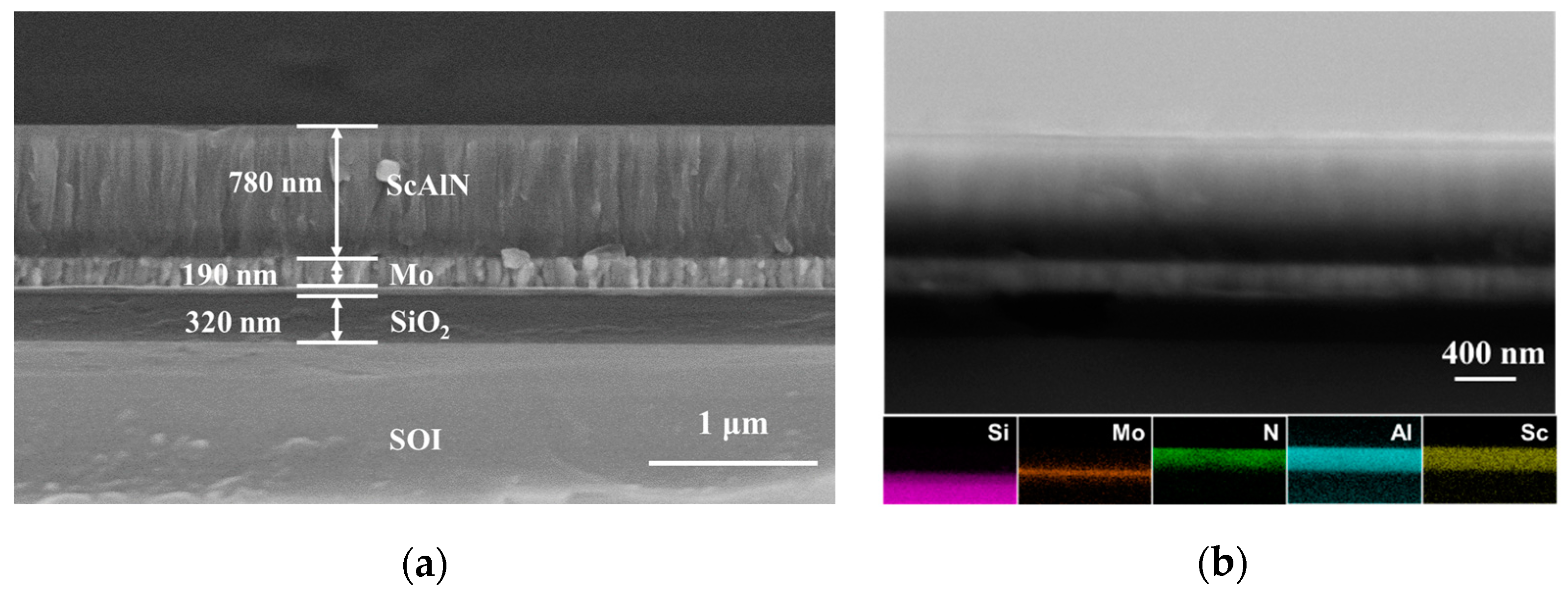
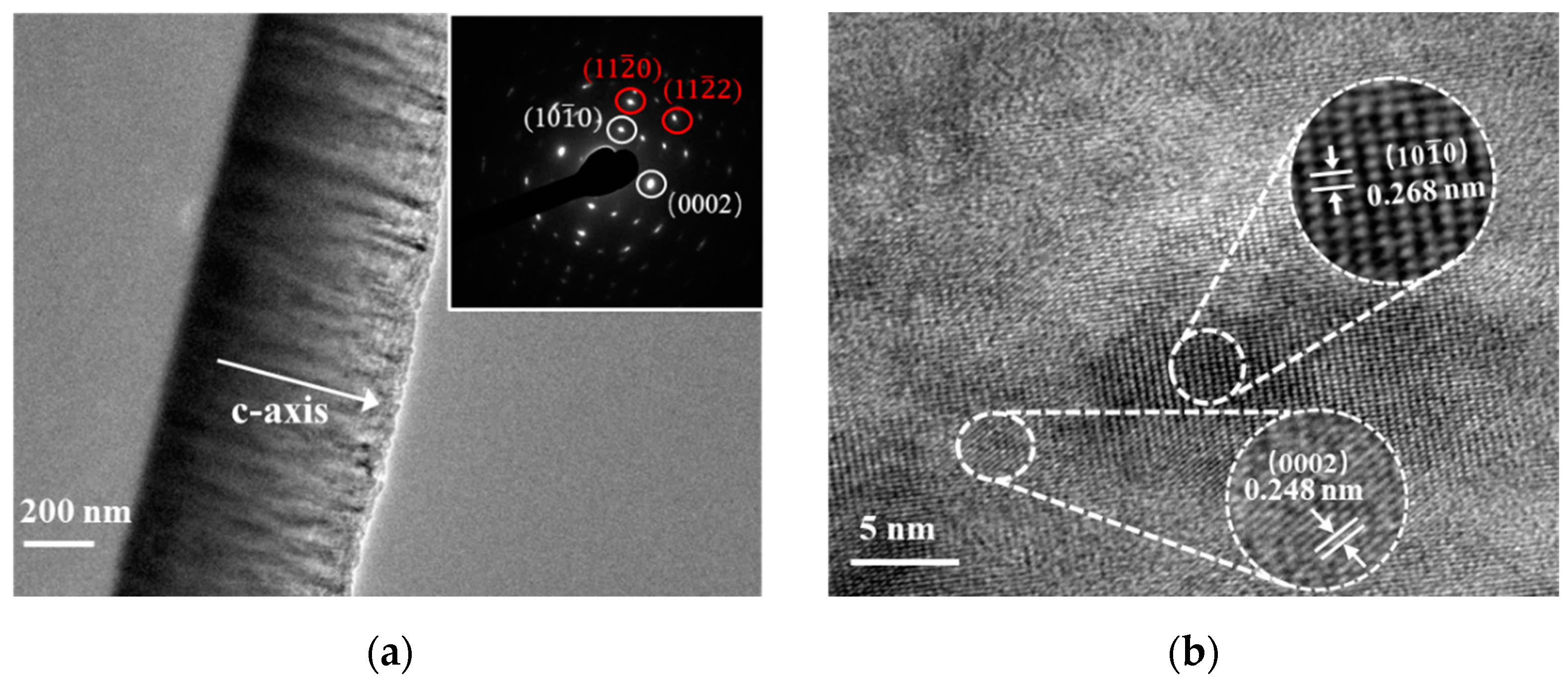


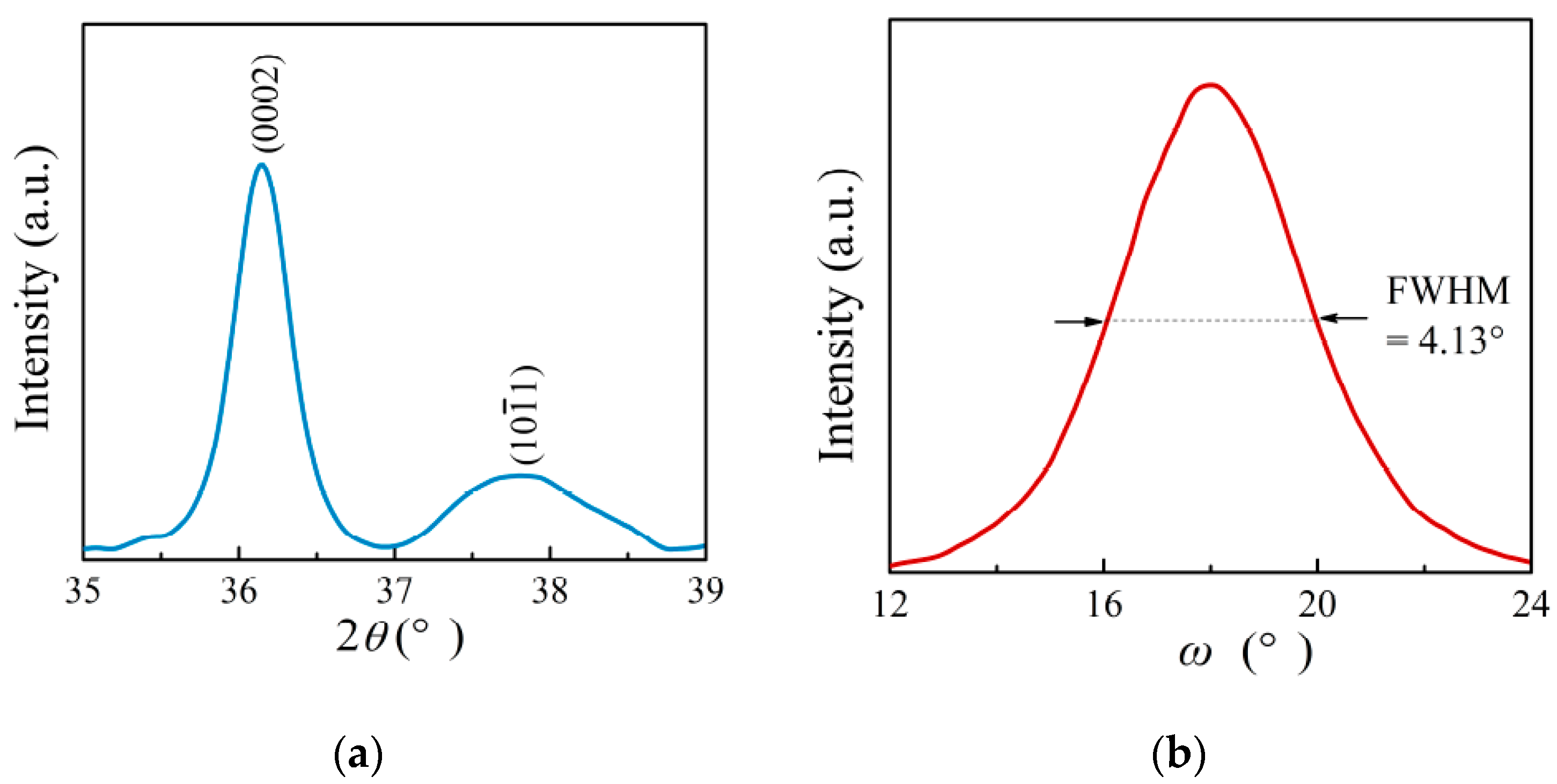
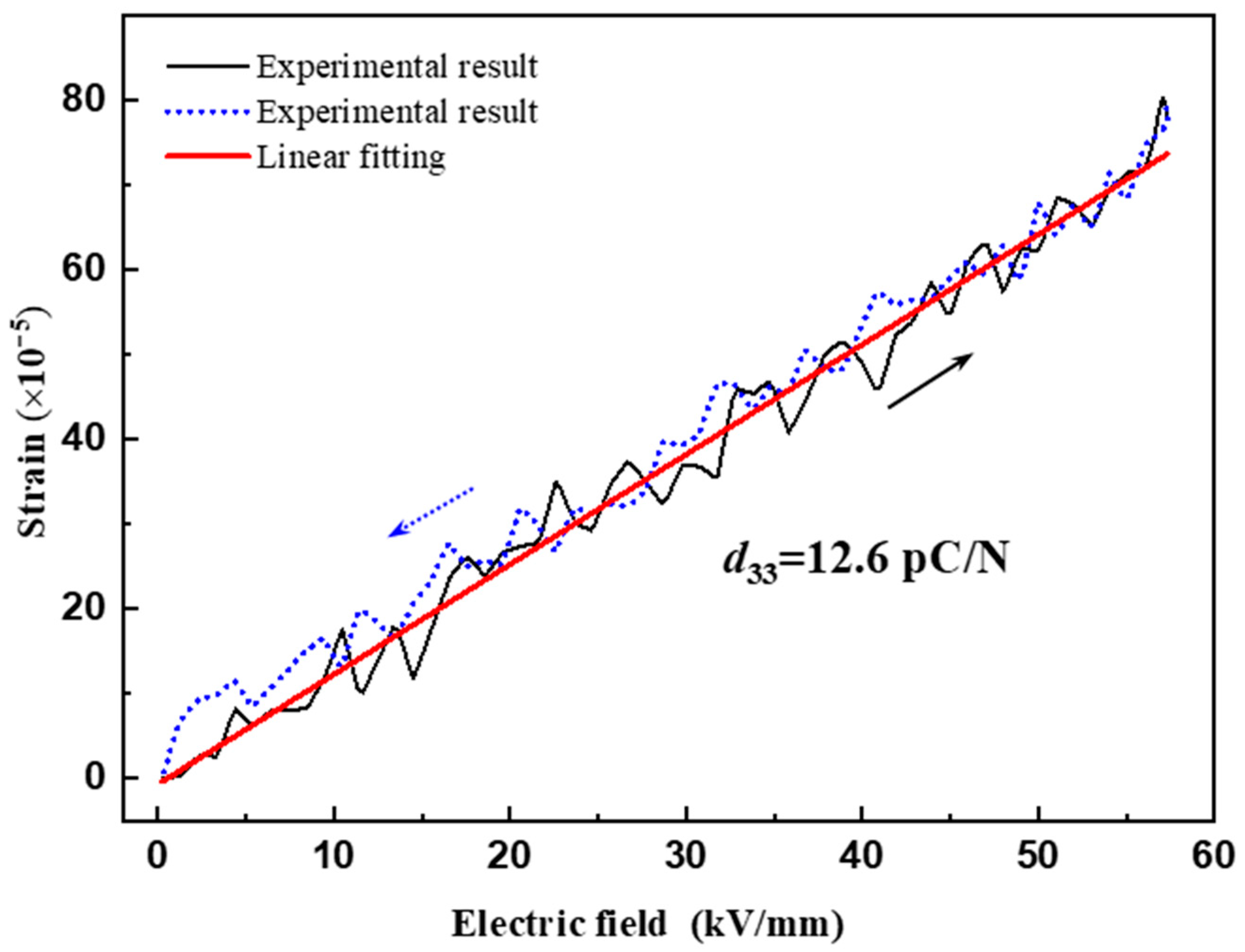
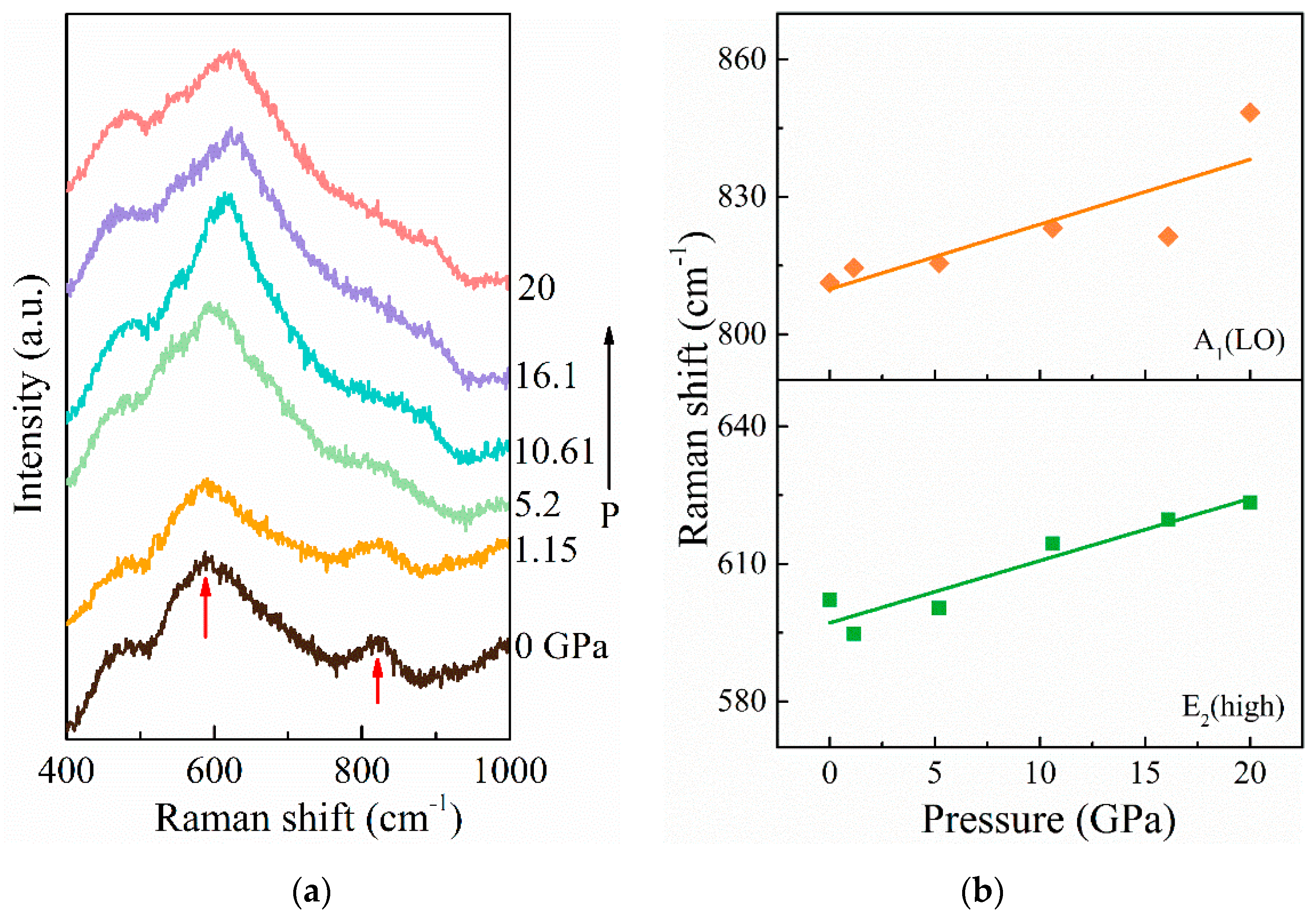
| Parameter | Value |
|---|---|
| Target-substrate distance | 70 mm (fixed) |
| Substrate temperature | 300 °C |
| Power | 7500 W |
| RF Bias | 60W |
| Total gas pressure | 2.6 mTorr |
| Gas composition ratio | Ar/N2 = 1/3 |
| Sputtering time | 20 min |
| Lattice Constant, a (Å) | |||||
|---|---|---|---|---|---|
| 3.4792 | 3.1356 | 3.1616 | 3.1578 | 3.5957 | 3.0657 |
| 3.2237 | 3.1889 | 3.2135 | 3.3515 | 3.1551 | 3.2530 |
| 3.1376 | 3.5382 | 3.1546 | 3.1498 | 3.1403 | 3.5532 |
| 3.1953 | 3.3510 | 3.2578 | 3.1545 | 3.2388 | 3.2537 |
| 3.1257 | 3.1010 | 3.4524 | 3.5965 | 3.0894 | 3.1694 |
| 3.3465 | 3.2212 | 3.2344 | 3.1632 | 3.3268 | 3.2614 |
| 3.1820 | 3.1744 | 3.4380 | 3.1018 | 3.5349 | 3.1677 |
| 3.2387 | 3.2443 | 3.3773 | 3.2424 | 3.3673 | 3.1387 |
| 3.5242 | 3.0646 | 3.2714 | 3.1521 | 3.0802 | 3.2563 |
| 3.2432 | 3.3938 | 3.1559 | 3.3191 | 3.2401 | 3.1299 |
| 3.1781 | 3.5284 | 3.2295 | 3.5410 | 3.1566 | 3.1619 |
| 3.3612 | 3.1769 | 3.2690 | 3.2273 | 3.1831 | 3.2497 |
| 3.2599 | 3.1557 | 3.3734 | 3.3310 | 3.2445 | 3.2025 |
| 3.6009 | 3.4151 | 3.1811 | 3.2286 | 3.1419 | 3.4969 |
| 3.0974 | 3.1456 | 3.3084 | 3.2209 | 3.4348 | 3.1904 |
Publisher’s Note: MDPI stays neutral with regard to jurisdictional claims in published maps and institutional affiliations. |
© 2021 by the authors. Licensee MDPI, Basel, Switzerland. This article is an open access article distributed under the terms and conditions of the Creative Commons Attribution (CC BY) license (https://creativecommons.org/licenses/by/4.0/).
Share and Cite
Zhang, Q.; Chen, M.; Liu, H.; Zhao, X.; Qin, X.; Wang, F.; Tang, Y.; Yeoh, K.H.; Chew, K.-H.; Sun, X. Deposition, Characterization, and Modeling of Scandium-Doped Aluminum Nitride Thin Film for Piezoelectric Devices. Materials 2021, 14, 6437. https://doi.org/10.3390/ma14216437
Zhang Q, Chen M, Liu H, Zhao X, Qin X, Wang F, Tang Y, Yeoh KH, Chew K-H, Sun X. Deposition, Characterization, and Modeling of Scandium-Doped Aluminum Nitride Thin Film for Piezoelectric Devices. Materials. 2021; 14(21):6437. https://doi.org/10.3390/ma14216437
Chicago/Turabian StyleZhang, Qiaozhen, Mingzhu Chen, Huiling Liu, Xiangyong Zhao, Xiaomei Qin, Feifei Wang, Yanxue Tang, Keat Hoe Yeoh, Khian-Hooi Chew, and Xiaojuan Sun. 2021. "Deposition, Characterization, and Modeling of Scandium-Doped Aluminum Nitride Thin Film for Piezoelectric Devices" Materials 14, no. 21: 6437. https://doi.org/10.3390/ma14216437
APA StyleZhang, Q., Chen, M., Liu, H., Zhao, X., Qin, X., Wang, F., Tang, Y., Yeoh, K. H., Chew, K.-H., & Sun, X. (2021). Deposition, Characterization, and Modeling of Scandium-Doped Aluminum Nitride Thin Film for Piezoelectric Devices. Materials, 14(21), 6437. https://doi.org/10.3390/ma14216437







